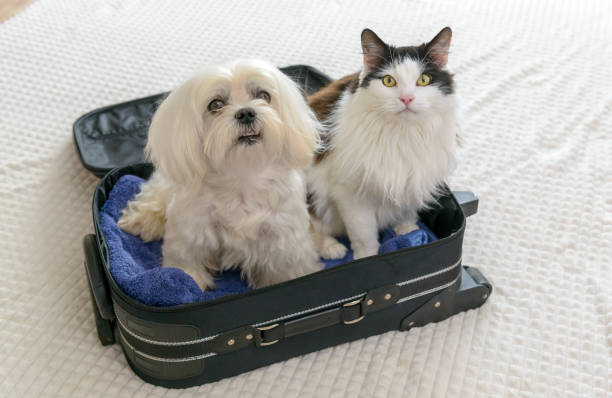Pet Travel: How to Plan a Trip with Your Dog or Cat
Traveling with your dog or cat can be a rewarding and enjoyable experience, but it requires thoughtful planning to ensure both you and your furry companion have a smooth journey. Whether you’re flying across the country, taking a road trip, or heading abroad, there are several key steps to consider—from pet-friendly accommodations to health requirements and transportation options. This guide will provide you with essential tips on how to travel with your pet, ensuring your trip is safe, comfortable, and fun for everyone involved.
1. Pre-Trip Preparation: Health, Paperwork, and Packing
Before embarking on your adventure, take the time to prepare both yourself and your pet for the trip. Here are some important steps to take in advance:
Health and Safety Check
- Vet Visit: Schedule a visit to your vet to ensure your pet is healthy and up to date on vaccinations. Some destinations (especially international locations) may require specific vaccines or health certificates.
- Pet Microchip: If you haven’t already, consider getting your pet microchipped or ensure they’re wearing a collar with an ID tag. It’s essential in case they get lost while traveling.
- Pet Insurance: Make sure your pet has health insurance that covers travel-related emergencies. Some policies provide coverage for accidents, illnesses, and emergencies while on the road.
Paperwork and Documentation
- Health Certificate: Many airlines and international destinations require a veterinary health certificate stating your pet is fit for travel. This often needs to be issued within 10 days of travel.
- Travel Permits: For international travel, check the import/export regulations for pets. Some countries may require additional paperwork like a rabies certificate, quarantine arrangements, or specific permits.
Packing for Your Pet
- Pet Travel Bag/Carrier: Invest in a comfortable, airline-approved pet carrier for your dog or cat. The carrier should be well-ventilated, large enough for your pet to stand, turn around, and lie down comfortably. If you’re traveling by car, a pet seat belt harness or booster seat may be a good alternative.
- Food and Water: Pack enough of your pet’s usual food to last the entire trip, along with a portable water dish. Some pets may experience digestive upset from food changes, so it’s best to stick to their familiar diet.
- Leash, Waste Bags, and Litter: Bring a collar and leash for dog walks and waste bags for clean-ups. If traveling with a cat, a portable litter box and litter are a must-have for long road trips.
- Pet Bed or Blanket: A familiar bed or blanket can provide comfort and a sense of security, especially if your pet is nervous or unsettled by new environments.
Travel Tip: Make sure you have a recent photo of your pet, especially if traveling abroad or with a pet passport. It can be helpful if your pet gets lost or if you need to make an emergency vet appointment.
2. Pet-Friendly Travel Accommodations
Finding the right accommodations is one of the most important aspects of traveling with your pet. Thankfully, many hotels, resorts, and vacation rentals now offer pet-friendly options.
How to Find Pet-Friendly Accommodation
- Use Pet-Friendly Booking Websites: Websites like BringFido, PetFriendly, and Airbnb allow you to search specifically for accommodations that welcome pets. These platforms often provide details on any pet restrictions (weight limits, breed restrictions, extra fees) as well as pet-friendly amenities.
- Call Ahead: While many accommodations claim to be pet-friendly, it’s always best to call ahead and confirm their pet policy. Some hotels may have breed restrictions, additional fees, or limits on the number of pets allowed per room.
- Look for Pet Amenities: Some pet-friendly hotels and rentals go the extra mile by offering pet amenities such as dog parks, pet beds, grooming services, or even room service for pets. Research these amenities in advance to ensure a more comfortable stay.
Pet-Friendly Accommodations Checklist
- Pet fee policies (one-time fee or daily charge)
- Weight or size limits
- Designated pet areas (such as a dog park or walking path)
- Local pet-sitting or daycare services
- Rules about leaving pets unattended in rooms
Travel Tip: If staying in a non-traditional pet-friendly accommodation (e.g., an Airbnb), check the reviews to see if previous guests had good experiences traveling with pets.
3. Traveling by Air with Your Pet
Flying with your pet can be a bit more complicated than road trips, but with the right preparation, it can be manageable. Whether your pet is flying in the cabin or as cargo, here’s what you need to know.
Choosing the Right Airline
- Airline Pet Policies: Each airline has its own pet travel policy, so it’s essential to research each carrier’s rules before booking your flight. Airlines like Delta, American Airlines, and United all allow pets in the cabin for a fee, but their size and breed restrictions can vary.
- In-Cabin vs. Cargo: Smaller pets (typically under 15-20 pounds) can usually fly with you in the cabin in a pet carrier. Larger pets may need to be checked as cargo. For cargo, make sure your pet’s carrier is sturdy, safe, and properly labeled.
Pet Travel Tips for Air Travel
- Book Early: Airline pet spots in the cabin are often limited, so book your pet’s travel as early as possible to secure a space.
- Pre-Flight Exercise: Before heading to the airport, take your pet for a long walk to burn off excess energy and reduce the risk of restlessness or anxiety during the flight.
- Stay Calm and Reassuring: Pets can pick up on your emotions, so try to stay calm and confident. Talk to your pet in a reassuring voice to help them feel more secure in unfamiliar surroundings.
Pet Travel Tip: If your pet is traveling in cargo, ensure the airline has a temperature-controlled environment and that the carrier is clearly labeled with your contact information and any special instructions.
4. Road Trip Travel with Pets
For many travelers, taking a road trip with a pet is the ideal way to enjoy a leisurely journey with your furry friend. With a little planning, both you and your pet can have a fun and safe road trip experience.
How to Plan a Pet-Friendly Road Trip
- Frequent Stops: Plan your route to include regular stops for bathroom breaks, stretching, and hydration. Most dogs enjoy the opportunity to explore new places, so include rest areas or pet-friendly parks along the way.
- Car Safety: Ensure your pet is secured while in the car. Use a pet seat belt harness, a pet carrier, or a dog booster seat to keep them safe and prevent distractions while driving.
- Prepare for Comfort: Pack a travel blanket or pet bed, and make sure your pet has plenty of space to relax during the ride. Pet seat covers can also protect your car’s upholstery from dirt and fur.
- Hydration and Snacks: Keep a portable water dish and snacks on hand to keep your pet hydrated and fed during the trip. It’s also a good idea to bring along your pet’s favorite toys or chew items to keep them entertained.
Pet-Friendly Road Trip Tip: Never leave your pet unattended in a hot car. Even on mild days, the temperature inside a parked car can rise to dangerous levels very quickly, so always bring your pet inside with you when you stop.
5. Special Considerations for International Travel
Traveling with a pet abroad requires additional preparation due to different regulations, quarantines, and health requirements depending on the country you’re visiting.
Research Destination Requirements
- Health and Vaccination Requirements: Each country has its own requirements for importing pets, including vaccines, health certificates, and even quarantine periods. For example, many European countries require pets to have a microchip, proof of rabies vaccination, and a pet passport.
- Quarantine: Some countries, like Australia and New Zealand, have strict quarantine rules that may require your pet to stay in quarantine for a period upon arrival.
- Airline and Airport Policies: International flights and airports often have specific pet protocols, including carrier specifications and customs declarations. Confirm all details in advance with your airline.
Travel Tip: If you’re flying internationally, consider using a pet relocation service that specializes in managing the logistics and paperwork of pet travel abroad.
6. Managing Pet Anxiety During Travel
Travel can be stressful for pets, particularly if they’re not used to being in new environments or confined to a carrier. Managing their anxiety will make the journey easier for both of you.
How to Calm a Nervous Pet
- Familiar Items: Bring along familiar toys, bedding, or a piece of your clothing with your scent to comfort your pet.
- Calming Products: There are several natural calming aids for pets, such as pheromone sprays or calming collars. CBD oil or anti-anxiety medication prescribed by your vet may also help your pet stay relaxed.
- Desensitization: If you’re preparing for a flight or long trip, practice shorter journeys leading up to your travel day. This helps your pet get used to being in a carrier or vehicle for extended periods.
A Successful Pet Travel Experience
Traveling with your dog or cat can be a fun, fulfilling experience if you take the time to plan ahead
and consider your pet’s comfort and safety. Whether you’re flying to a new city or hitting the open road, always check pet policies, ensure all health and safety requirements are met, and make sure your pet is prepared for the adventure. With a little extra care, your furry friend can be the perfect travel companion, creating lifelong memories along the way!
Safe travels to you and your pet—may your journeys be full of adventure, relaxation, and tail wags! 🐾✈️🚗


